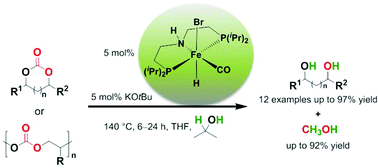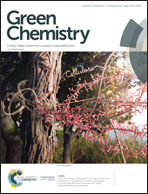Transfer hydrogenation of cyclic carbonates and polycarbonate to methanol and diols by iron pincer catalysts†
Abstract
Herein, we report the first example on the use of an earth-abundant metal complex as the catalyst for the transfer hydrogenation of cyclic carbonates to methanol and diols. The advantage of this method is the use of isopropanol as the hydrogen source, thus avoiding the handling of flammable hydrogen under high pressure. The reaction offers an indirect route for the reduction of CO2 to methanol. In addition, poly(propylene carbonate) was converted to methanol and propylene glycol. This methodology can be considered as an attractive opportunity for the chemical recycling of polycarbonates.

- This article is part of the themed collection: International Symposium on Green Chemistry 2019


 Please wait while we load your content...
Please wait while we load your content...